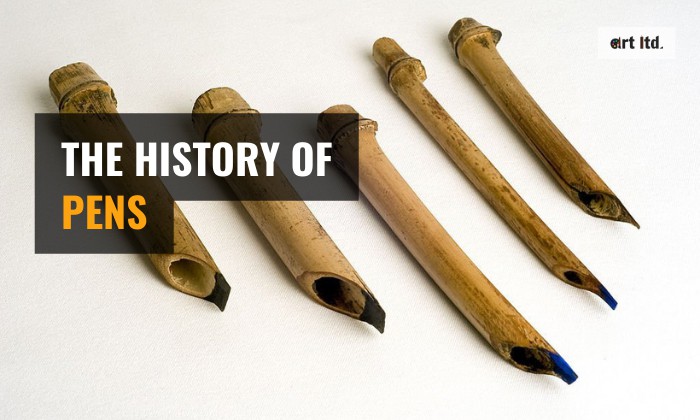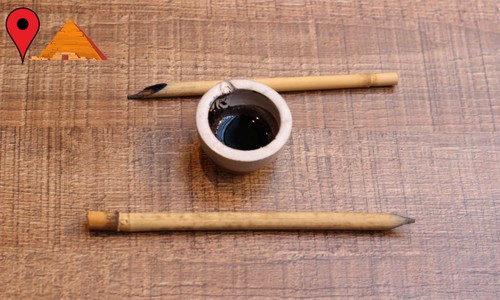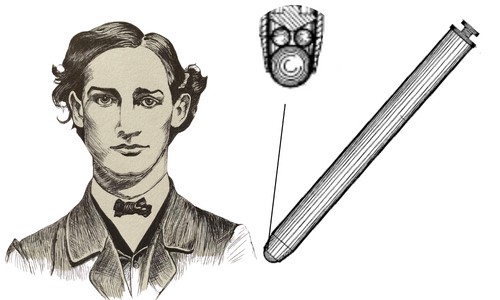As we travel through the history of pens, we gain a perspective of the evolution of these writing implements and their significant influence on our writing techniques and everyday lives, akin to the revolutionary effects of telephones and light bulbs ever since their inception.
Right before modern pens, pens were mere fragments of reed or quill that required dipping into an ink bottle to write. Thankfully, the progressive development of pen invention has immensely simplified writing and communication.
So, when were pens made? In this article, we are going to track the origin of pens and the early writing tools that paved the way for modern pen designs.
Table of Contents
Tracing the Roots: The Early Writing Tools
1. The Ancient Pen: The Reed Stylus and Reed Pen
It was the Egyptians who invented the earliest form of writing instrument known as the reed stylus.
This ancient stylus was derived from a hollowed-out reed or stalk of a plant, typically a bamboo piece, crafted with a sharpened tip to make stylus writing impressions, hieroglyphs, or carvings on surfaces such as wax or clay tablets.
Around that same time, Egyptians would invent pen inks or pigments, which were usually sourced from vegetable extracts, water, soot, and animal skin. With this milestone, the birth of the reed pen commenced, which would be the first pen that can write on papyrus.
This primitive writing implement would be dipped into ink or pigment to create bold and dark strokes on papyrus. The reed pen, which is a dip pen, was intricately carved with a split in the point or nib to hold an ample amount of ink until it would be dispensed over a writing surface.
Today, a stylus instrument is a tool or metal pen designed with a rubber tip and is used to easily navigate devices like phones, tablets, and other touchscreen electronics.
2. The Medieval Writing Tool: The Quill Pen
The use of reed pens started to decline when quill pens emerged in 600 AD.
Between the 7th and 19th centuries, the quill pen was used extensively until the development of the fountain and modern steel pens. In fact, the quill pen was the prominent writing tool that had been used for the longest period among all similar inventions in history.
Europeans innovatively developed the quill pen using different large bird feathers, particularly swans, geese, and turkeys.
The feathers would undergo meticulous preparation using moderate heat for optimal drying and elimination of residues and oils. This process would ensure the capability of the quill pen to hold the ink effectively.
Then, the tips were carefully shaped and sharpened to hold a point. A slit on one side of the pointed tip would serve as the pen’s ink reservoir. Such a design also made quill pens more flexible to use than reed pens with its various customizable tip sizes.
When the quill pen is dipped into ink, capillary action takes place, which would provide longer intervals between dipping.
3. The Portable and Self-Fuelling Pen: The Fountain Pen

The timeline of the fountain pen history unfolds long and complicated events, with countless discussions about who the original fountain pen inventors are or who had been granted the first patents.
After all, any pen design that consists of an ink reservoir and utilizes a metal nib to transfer ink to paper features the concept of a fountain pen. Hence, confusion about the fountain pen’s production and origin has been prevalent.
When were the pens invented, then? The following timeline shows the detailed archives of the origin, innovations, and evolution of the tool:
10th Century (953 AD)
In 953 AD in Arab Egypt, Fatimid caliph Al-Mu’izz li-Din Allah was believed to have commissioned the construction of the first fountain pen. As recorded by an official historian of the Fatimid Caliphate in 974 AD, Al-Mu’izz demanded a type of pen that would write effortlessly without staining his clothes or hands.
A craftsman had granted his request and presented him with a pen adorned with gold trimmings. The pen featured an ink reservoir, which could be held conveniently or even turned upside down without ink leaks.
1636
Daniel Schwenter improvised a concept of a fountain pen using different parts of seven quill pens. He was able to construct a two-part instrument: one part used as an ink reservoir inside the other part (quill). A cork was used to seal the ink inside the quill.
Circa 1689 – 1702
Nicholas Bion was known to have designed the oldest fountain pen in the world, referred to as the “Bion pen” or “the endless pen”. These pens relied on air pressure and featured a bore that allowed ink to move through. They were constructed with metal and cut quills for the nibs.
However, there was no record that Bion had received any patent for his design.
1809
Frederick Fölsch was considered the official inventor and had been granted the first English patent for the fountain pen in May 1809.
In the same year, locksmith and inventor, Joseph Bramah, made developments for the ink feeder using his machine that could manufacture quill pen nibs. He filed an English patent for this invention in September 1809.
1827
Petrache Poenaru patented a fountain pen in Paris, France. He used a large swan quill to design a fountain pen barrel. The design unfortunately had issues with blotting.
1828
John Mitchell introduced the machine that started the mass production of steel-point pen nibs in Birmingham, England. They were much cheaper but more durable than traditional quill pens, though these tools would be dipped into ink like the quill type.
1832
John Jacob Parker innovated a practical ink cartridge design (self-filling mechanism) using a piston screw, which enables the fountain pen to draw ink inside the barrel using a squeezable rubber sac.
1884
Lewis Waterman was known to have invented the first ever modern fountain pen design that utilized capillary action through a three-channel ink feed and gravity to dispense ink out of the reservoir. His concept allowed fountain pens to regulate ink flow, preventing messy leaks.
1897
George Safford Parker of the Parker Pen Company invented and patented the Jointless Lucky Curve fountain pen, the first ever leak-free Parker pen.
This pen highlighted the Lucky Curve mechanism that could hold and store ink so the pen would be ready for use at all times. It was touted for its ability to keep hands clean and free of stains.
4. The Turning Point in Pen History: The Ballpoint Pen
The ballpoint pen consists of a tiny steel ball that rotates in a socket and is constantly bathed in fast-drying ink, which is then transferred to paper.
The evolution of the ballpoint pen unveiled twists and turns in history, unfolding a series of correlated inventions and developments that would lead to the success of the tool.
1888
The inspiration behind Loud’s invention started when he wanted a way to write and mark rough surfaces successfully, which fountain pens could not do.
His pen invention did work on rough surfaces and leather, but its lack of compatibility with paper and unsatisfactory ink flow hindered its commercial value.
1938
László Bíró patented the first modern ballpoint pen, also referred to as the “biro” pen, which had also been commercially successful since then. He worked alongside his chemist brother, György, and discovered the correct ink type and viscosity to use in a pen with Loud’s patented rotating ball design.
His invention allowed ballpoint pens to dispense a steady ink flow and write smoothly on paper without smudging and leaking.
1946
Marcel Bich of the BIC pen company bought László Bíró’s original patent and elevated the ballpoint pen design using stainless steel balls. BIC Cristal, Bich’s first ballpoint pen, was manufactured in 1950 and eventually became a commercial success.
Cultural and Historical Significance of Pens
Pens allow humans to pass on ideas and preserve important events, stories, and books throughout history. The invention and evolution of pens not only made writing easier but also facilitated the exchange of knowledge and the development of trade and diplomacy.
These instruments are timeless mediums for personal expression, creativity, and innovation, giving life to countless artworks, historical documents, and musical scores.
Conclusion
Revisiting the history of pens and their major developments helped us value the significance of these writing implements. These inventions changed our perspective toward writing and communication, allowing us to convey our thoughts as well as express ourselves artistically.
So, the next time you use your pen to jot down notes, sign documents, or draw sketches, you will remember the vast trail of history that made this writing tool one of the greatest inventions of all time.

Art has always been a part of my life; it influences my upbringing and later my career choice. For me, it is always a part of my parenting technique. So for whichever purpose that you come to art, you can start here with us.




